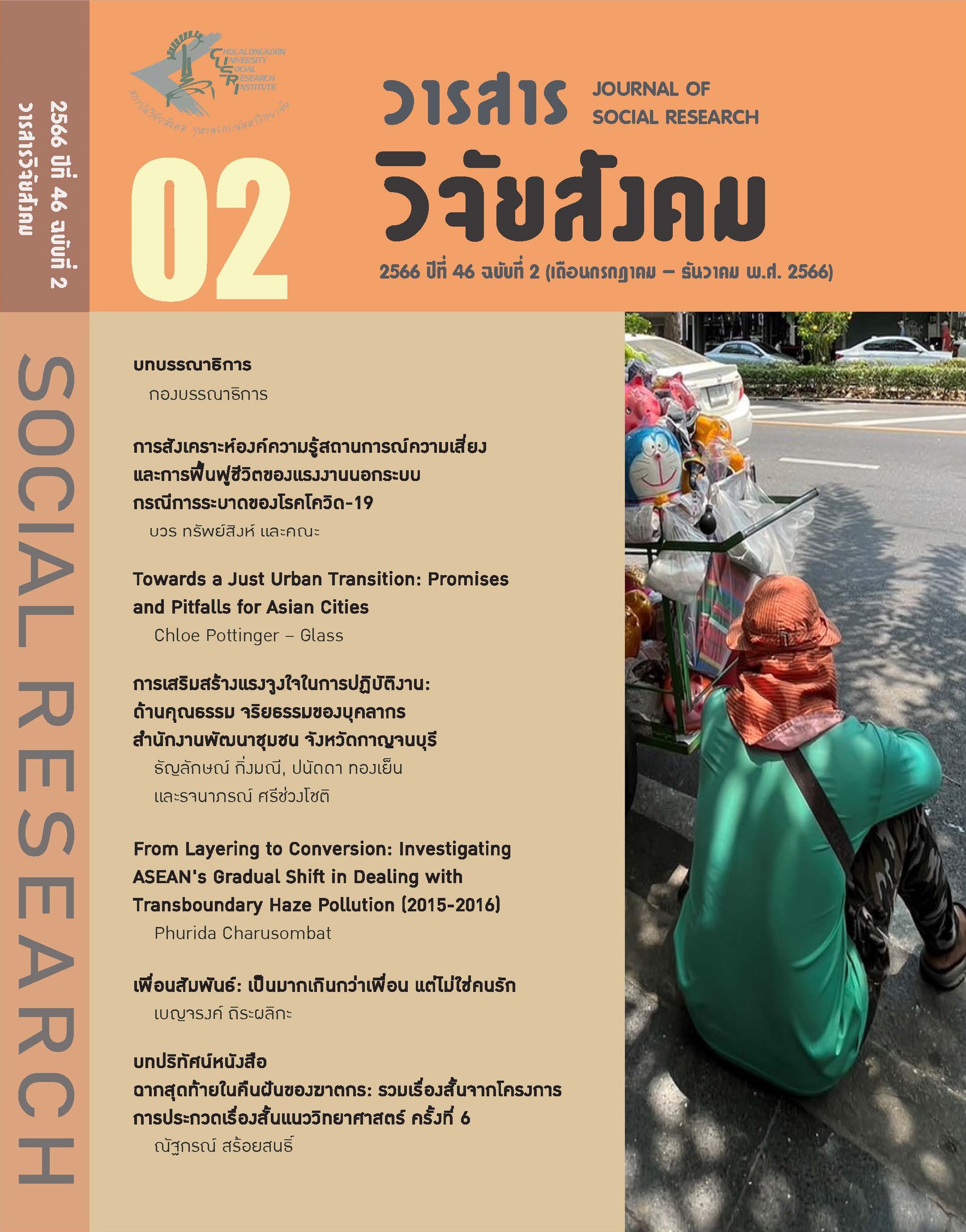Friends with Benefits Relationships: more than friends, but not lovers
Main Article Content
Abstract
Researchers will pursue knowledge, truth, kindness, and beauty through a variety of approaches. According to Professor Robert V. Kozinets' technique, ethnographic methods can also directly access human sentiments both offline and online, particularly when the topic of study is sensitive to information and truth disclosure. For this reason, the researcher decided to use this technique to gather data. During the course of an eight-month study, five males who had sex with men (MSM) couples and are in FWB status were chosen for the sample. Starting from February to October 2023.
According to the study's results, Friends with benefits relationships (FWBRs) are distinct from traditional couples in just one path: they make the decision to date for the long term. When feelings arise, there has to be mutual trust, heart-to-heart understanding, and the ability to support one another. Moreover, it is certain that a culture steeped in intolerance has traditionally been a major contributor to the FWB phenomenon. The Disgrace and Contempt Culture. People have to look for answers in order to have their needs met.
Article Details

This work is licensed under a Creative Commons Attribution-NonCommercial-NoDerivatives 4.0 International License.
- The copyright for this article belongs to the Social Research Institute at Chulalongkorn University. However, the views and content within are solely those of the authors.
- The views and opinions expressed in the articles published in the Journal of Social Research and Review, Social Research Institute, Chulalongkorn University, are the sole responsibility of the authors and do not reflect the views or responsibilities of the editorial board of the Journal of Social Research and Review, Social Research Institute, Chulalongkorn University. The editorial board does not reserve the rights to reproduction but requires proper citation for referencing.
References
ธเนศ วงศ์ยานนาวา. (2562). ว่าด้วยเพศ: จากธรรมชาติ สู่จริยธรรม จนถึงสุนทรียะ และหุ่นยนต์ (On Sex) (พิมพ์ครั้งที่ 4.). นนทบุรี: สำนักพิมพ์สมมติ.
เบญจรงค์ ถิระผลิกะ. (2564). บทปริทัศน์หนังสือเรื่อง “ว่าด้วยเพศ: จากธรรมชาติ สู่จริยธรรมจนถึงสุนทรียะและหุ่นยนต์ (On Sex)”. วารสารวิจัยสังคม สถาบันวิจัยสังคม จุฬาลงกรณ์มหาวิทยาลัย, 43(2): 221-233.
ภาณุ สหัสสานนท์. (2561). Friends with benefits หรือเรียกสั้นๆ ว่า F.W.B. คือ ความสัมพันธ์รูปแบบหนึ่งที่เพื่อนทำหน้าที่ร่วมหลับนอนกับเพื่อน. (ออนไลน์), เข้าถึงได้จากhttps://www.facebook.com/PsychologyChula/posts/1906381469476257:0. (เมื่อวันที่ 21 พฤศจิกายน 2566).
รณภูมิ สามัคคีคารมย์ และคณะ. (2551). เพศวิถีในสื่อนิยม: บริบทเสี่ยงและเสริมต่อสุขภาวะทางเพศ. กรุงเทพมหานคร: สำนักงานกองทุนสนับสนุนการสร้างเสริมสุขภาพ (สสส.) และสถาบันวิจัยประชากรและสังคม มหาวิทยาลัยมหิดล.
สีตลา ชาญวิเศษ. (2559). บทบาทเครือข่ายสังคมออนไลน์ในการพัฒนาความสัมพันธ์แบบโรแมนติก. (นิเทศศาสตรมหาบัณฑิต). จุฬาลงกรณ์มหาวิทยาลัย, กรุงเทพมหานคร.
Afifi, W. A., & Faulkner, S. L. (2000). On BeingJust Friends': The Frequency and Impact of Sexual Activity in Crosssex Friendships. Journal of Social and Personal relationships, 17(2): 205-222.
Brehm, S. S., Miller, R. S., Perlman, D., & Campbell, S. M. (1992). Intimate relationships: McGraw-Hill New York.
Garcia, J. R., Reiber, C., Massey, S. G., & Merriwether, A. M. (2012). Sexual hookup culture: A review. Review of General Psychology, 16(2): 161-176.
Hetland, P., & Mørch, A. I. (2016). Ethnography for investigating the Internet. Paper presented at the Seminar. net.
Hine, C. (2000). Virtual ethnography. [Online]. Retrieved from https://doi.org/10.4135/9780857020277. (Accessed 1 November 2023).
Hughes, S. A., & Pennington, J. L. (2016). Autoethnography: Process, product, and possibility for critical social research: Sage Publications.
Humphreys, L. (1975). Tearoom trade, enlarged edition: Impersonal sex in public places: Transaction Publishers.
Kelly, M. (2005). The Seven Levels of Intimacy: The Art of Loving and the Joy of Being Loved: Simon and Schuster.
Knack, S., & Keefer, P. (1997). Does social capital have an economic payoff? A cross-country investigation. The Quarterly journal of economics, 112(4): 1251-1288.
Kozinets, R. V. (2010). Netnography: Doing ethnographic research online: Sage publications.
Lloyd, S. L. (2023). Friends With Benefits: What Does It Mean and Is It Right for You? RELATIONSHIPS LOVE & DATING. [Online]. Retrieved from https://www.brides.com/what-does-friends-with-benefits-mean-1021859. (Accessed 1 December 2023).
Machia, L. V., Proulx, M. L., Ioerger, M., & Lehmiller, J. J. (2020). A longitudinal study of friends with benefits relationships. Personal Relationships, 27(1): 47-60.
Morley, D. (1989). Changing paradigms in audience studies. Remote control: Television, audiences, and cultural power, 16-43.
Munroe, M. (2005). Waiting and dating: A sensible guide to a fulfilling love relationship: Destiny Image Publishers.
Options for sexual health. (2020). INTIMACY AND RELATIONSHIPS. [Online]. Retrieved from https://www.optionsforsexualhealth.org/facts/sex/intimacy-and-relationships/. (Accessed 1 November 2023).
Taylor, D. A., Wheeler, L., & Altman, I. (1973). Self-disclosure in isolated groups. Journal of Personality and Social Psychology, 26(1): 39-47.
Tirapalik, B. (2021). MSDA AUTO ETHNOGRAPHY: A Study of Men Who Have Sex and Use Drugs to Build Camaraderie and Networks with One Another. Phranakhon Rajabhat Research Journal (Humanities and Social Sciences), 16(2): 195-211.
Tirapalika, B. (2022). The S-CP2D model: The process of building the intimate relationship among MSM-Men who have an intimate relationship or sexual intercourse with men-within Twitter. Kasetsart Journal of Social Sciences, 43(3): 547–552.
Tom Bruett. (2019). How to build intimacy in gay relationships. [Online]. Retrieved from https://is.gd/ACjKaM. (Accessed 1 September 2023).
Vanderdrift, L. E., Lehmiller, J. J., & Kelly, J. R. (2012). Commitment in friends with benefits relationships: Implications for relational and safe‐sex outcomes. Personal Relationships, 19(1): 1-13.


